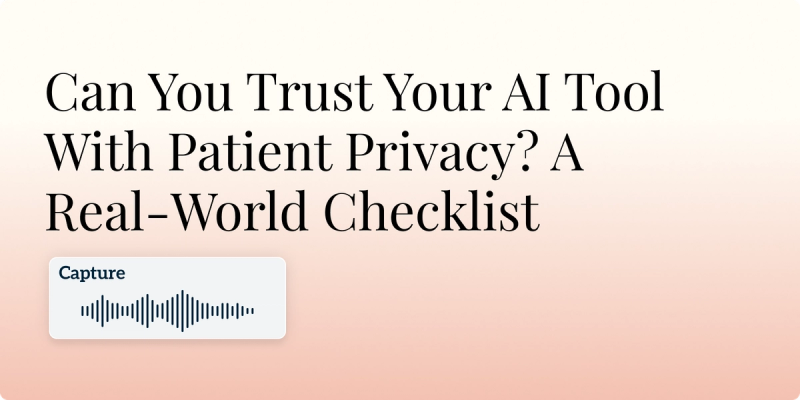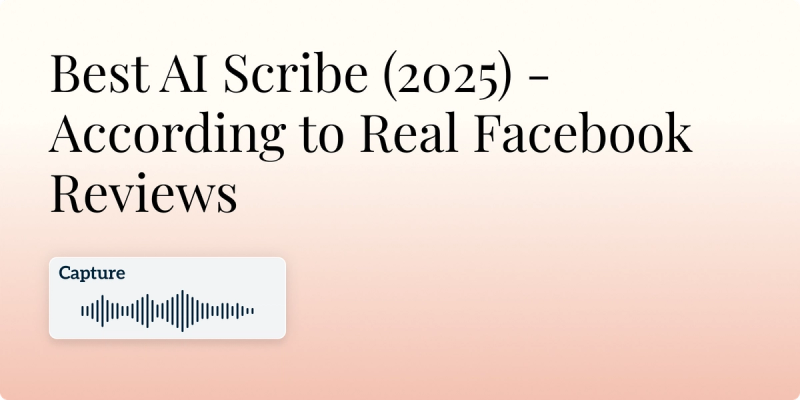
Can You Trust Your AI Tool With Patient Privacy? A Real-World Checklist

The integration of AI into healthcare represents a paradigm shift in efficiency and clinical insight. But this powerful tool introduces a critical vulnerability: the security of your patients’ most sensitive data. Entrusting session transcripts to a third‑party platform isn't a decision to be taken lightly. Vague promises of “compliance” are not enough.
How can you, as a practitioner, move beyond marketing buzzwords to verify that an AI tool meets the rigorous technical and legal standards required to protect patient privacy and your practice’s compliance? This real‑world checklist provides the technical questions you need to ask to ensure your trust is well‑placed.
The Foundation of HIPAA-Compliant AI Notes
Before delving into some of the technical specifics of AI data security, two foundational items separate compliant vendors from the rest. Consider these your first and most critical filters.
Checklist Item 1: Is the Vendor Willing to Sign a Business Associate Agreement (BAA)?
- Why it Matters: This is the legal bedrock of HIPAA compliance. Any vendor that handles, stores, or processes your patients’ Protected Health Information (PHI) is legally considered a Business Associate. A BAA for AI notes is a non-negotiable contract that outlines its specific responsibilities for safeguarding that data and makes it legally liable for protecting it. A vendor's refusal or hesitation to sign a BAA is an immediate and absolute deal-breaker.
Checklist Item 2: Does the Vendor Have Independent, Third-Party Security Attestations?
- Why it Matters: Anyone can claim their platform is ‘secure’. Independent audits provide the proof.
- Example: When vetting a vendor, look for a SOC 2 type II report. Unlike a simple checklist or a SOC 2 Type I (which checks controls at a single point in time), a Type II report is an extensive audit that proves the vendor's security controls (like encryption, access management, and risk mitigation) have been consistently operating effectively over a period of time, typically 6-12 months.
Data Encryption and Anonymization
Once the legal and audit frameworks are confirmed, you must understand how data is protected at a technical level.
Checklist Item 3: How Is My Data Encrypted, Both In Transit And At Rest?
- Why it Matters: Encryption scrambles data so it's unreadable without a key. It must be applied while data is moving to the vendor's servers and while it is stored there.
- Example: Demand specifics. Acceptable answers include:
- In-transit: TLS 1.2 or 1.3. This is the same encryption protocol that secures your online banking, creating a secure tunnel between your browser and server.
- At-Rest: AES-256 encryption. This is the global standard for encrypting stored data and is considered a military-grade standard. It ensures that even if someone gains unauthorized access to the physical servers, the data files themselves remain unintelligible.
Checklist Item 4: Is Patient Data Anonymized or Pseudonymized Before Processing?
- Why it Matters: This is a critical privacy-by-design feature. The AI does not need to know the patient's name to analyze the clinical content of a session.
- Example: A secure system should not process raw, identifiable transcripts. Instead, it should automatically replace direct identifiers (like name, medical record number, date of birth) with a unique random token. This process, known as pseudonymization, drastically limits the exposure and usability of data in the event of a breach.
Operational Safeguards
These operational questions are critical for maintaining the day‑to‑day integrity of your HIPAA-compliant AI notes system.
Checklist Item 5: Is My Data Used to Train the AI model?
- Why it Matters: Your patient sessions are your intellectual property and contain intensely private information. They must not be used to improve a vendors general-purpose AI model, which could potentially expose sensitive information.
- What to Listen For: The answer must be an unambiguous ‘No’. Your data should be logically siloed and used solely for processing your notes and generating insights for your practice alone.
Checklist Item 6: Do I Have Full Control Over Data Deletion?
- Why It Matters: HIPAA grants patients rights over their data, and your practice is responsible for honoring requests to amend or delete records. You cannot be dependent on the vendor’s complicated process or reluctance.
- Example: You must have a guaranteed, straightforward process in place to permanently delete all traces of a patient's data, including raw transcripts, analyzed outputs, and notes, from the vendor's systems. This is essential for complying with HIPAA’s “Right of Access” and is a core principle of data minimization.
Conclusion
Trust in a clinical AI tool is not given; it is earned through demonstrable, verifiable security practices. This checklist moves you from hoping a vendor is compliant to knowing they are.
Use these questions in your conversation with AI vendors. A trustworthy provider will have clear, confident, and technically specific answers. They will welcome your diligence. Remember, protecting patient privacy with these tools isn't just a box to check for compliance; it is the digital extension of the confidentiality and fundamental trust that form the very foundation of the therapeutic relationship.
Frequently Asked Questions
ABOUT THE AUTHOR
Gal Steinberg
Co-founder
Reduce burnout,
improve patient care.
Join thousands of clinicians already using AI to become more efficient.

The Best AI Scribe in 2025 - According to Real Facebook Reviews (October 2025)
We read real Facebook reviews to rank the best AI scribe tools of 2025. See authentic quotes, pros & cons, and find your recommended AI scribe fast.

Is There a Free AI Scribe for Clinicians? (2025)
Are any AI medical scribes truly free? We review prices, limits, HIPAA realities, and 2025 news - and show the closest-to-free option.

Best AI Scribe for Small Medical Practices (2026) - Comparison, Pricing & More
Compare the 7 best AI scribes for small medical practices in 2026—cost, speed, HIPAA, reviews—to choose the right tool and reclaim hours of charting time.

